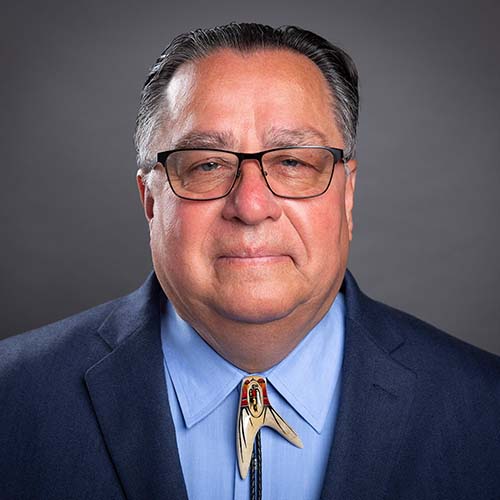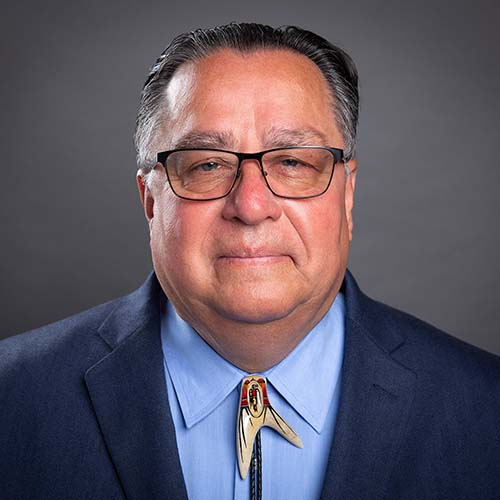
- Details
- By Levi Rickert
Opinion. Shortly after 9 a.m. last Tuesday, Leonard Peltier (Turtle Mountain Ojibwe) was released from the Federal Correctional Complex in Coleman, Fla., and driven to the Leesburg airport to be flown to North Dakota.
President Joe Biden made freedom possible for the American Indian Movement (AIM) member when he granted Peltier a commuted sentence just before he left office.
Last Tuesday, under a bright sun but bitterly cold conditions, with temperatures plunging to 8 degrees below zero and winds sweeping across the Great Plains, I stood alongside other journalists amid a growing crowd of over 100. Their vehicles lined Highway 281, just east of Belcourt, North Dakota, on the reservation side of a green sign with white lettering that read, “Welcome to the Turtle Mountain Reservation.”
To keep warm, people moved in and out of their vehicles as well-wishers honked their horns while passing by. The loudest sound, perhaps, came from a propane delivery truck. Others relied on packets of hand warmers that had been distributed to fend off the cold.
After waiting for more than an hour, a crowd of family, friends, and fellow tribal members welcomed home the most famous citizen of the Turtle Mountain Band of Chippewa Indians, Leonard Peltier.
The atmosphere along Highway 281 was celebratory. Some of Peltier’s relatives waved signs, a few reading “Welcome Home, Grandpa” and “Welcome Home, Cuz.” Over 100 signs featuring an iconic image of Peltier and the words “Miigwech, Leonard Peltier” were handed out.
Standing there Tuesday afternoon, I realized many of his grandchildren had never met their grandfather because Peltier had been incarcerated for 49 years. Convicted of killing two FBI agents during a shootout at the Jumping Bull Ranch in Oglala, S.D. on the Pine Ridge Indian Reservation, Peltier was coming home.
The moment carried historical significance — seeing such an iconic figure return to the reservation where he spent much of his childhood. Having read multiple books about him and written opinion pieces advocating for his release through the years, I now witnessed his long-awaited homecoming that, to be quite frank, many doubted would ever happen.
I observed this moment among his family, friends, and fellow Turtle Mountain tribal members, alongside other journalists.
Another realization emerged: while many AIM leaders have died, Leonard Peltier lives on. I spent time with AIM co-founder Dennis Banks (Leech Lake Ojibwe) before his passing, covering his 2011 Longest Walk—Reversing Diabetes journey from California to Washington, D.C. during the launch of Native News Online. I also hosted Clyde Bellecourt (White Earth Ojibwe) at a Grand Rapids symposium during my time leading an urban Indian center, and interviewed Russell Means (Oglala Sioux Tribe), one of AIM's most recognized voices.
That Tuesday, I reflected: They are gone, yet Leonard Peltier remains. He is no longer in federal prison, where he endured years of solitary confinement and lockdowns, including during the COVID-19 pandemic.
I considered how most Americans—and many around the world—recognize Peltier primarily as an icon. They know his image from posters and bumper stickers that read “Free Leonard Peltier,” picturing him with long dark hair and a mustache. But seeing his family lining Highway 281 made him more than a symbol.
This reminded me of something Nick Tilsen, founder and CEO of NDN Collective, said last December, the day after the White House Tribal Nations Summit. Speaking to a group of tribal leaders at the Indian Gaming Association, he noted that during Peltier’s parole hearing last June, the only time Peltier was truly humanized was when his Indian boarding school experience was mentioned.
As the caravan crawled forward, its pace reduced to a crawl, the back windows of a white Jeep Wagoneer were rolled down. Inside, I saw Tilsen seated on the right in the back seat. Beside him sat Holly Cook Marcarro, NDN Collective’s government affairs coordinator. And then, I saw Leonard, sitting behind the driver.
Holly shouted, “Levi!” Then I heard Leonard echo, “Levi!” The moment humbled me. In that instant, I saw beyond the icon. I saw Leonard Peltier, the man.
Now 80 years old, he sat with a smile on his face, his fist clenched in triumph. Though no longer behind bars, he remains confined—this time to house arrest. I want to learn more about the man behind the legend, no longer subjected to solitary confinement, finally able to rest on a real mattress rather than a thin prison-issued one.
Thayék gde nwéndëmen - We are all related.
More Stories Like This
Colorado cannot heal until it confronts Sand Creek honestlyNative American Mothers Deserve to Live
Technology Rooted in Tradition is Strengthening Cherokee Nation
The Lumbee Tribe of North Carolina: #575
Tribes Do Not Need a Greenlight to Build Renewable Energy
Help us defend tribal sovereignty.
At Native News Online, our mission is rooted in telling the stories that strengthen sovereignty and uplift Indigenous voices — not just at year’s end, but every single day.
Because of your generosity last year, we were able to keep our reporters on the ground in tribal communities, at national gatherings and in the halls of Congress — covering the issues that matter most to Indian Country: sovereignty, culture, education, health and economic opportunity.
That support sustained us through a tough year in 2025. Now, as we look to the year ahead, we need your help right now to ensure warrior journalism remains strong — reporting that defends tribal sovereignty, amplifies Native truth, and holds power accountable.
 The stakes couldn't be higher. Your support keeps Native voices heard, Native stories told and Native sovereignty defended.
The stakes couldn't be higher. Your support keeps Native voices heard, Native stories told and Native sovereignty defended.
Stand with Warrior Journalism today.
Levi Rickert (Potawatomi), Editor & Publisher


